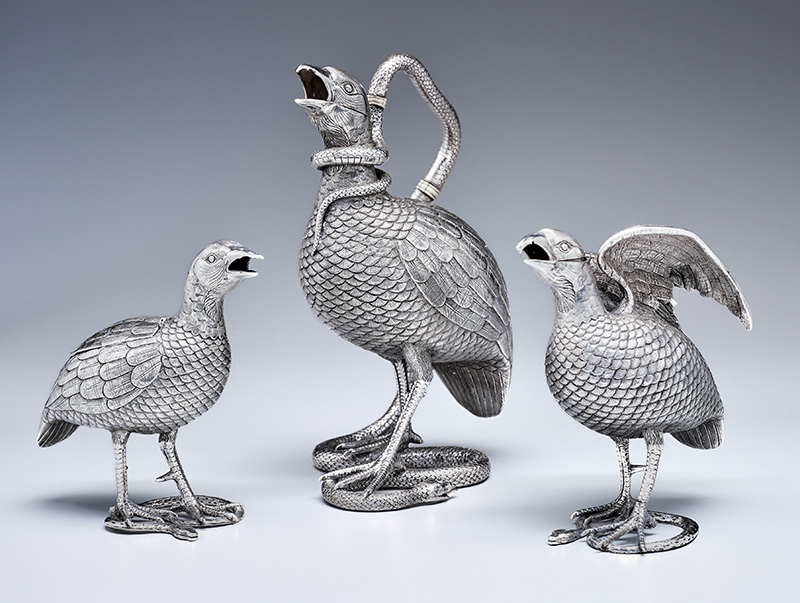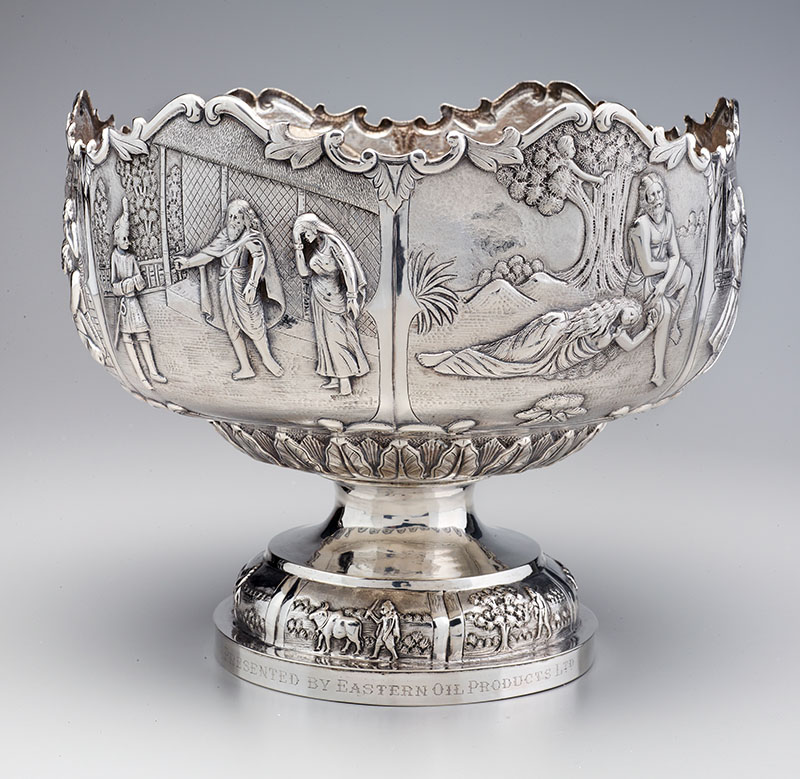The Silvered Stories of 19th-Century Southern Asia
Click on images to enlarge them and view captions.
by Katherine Anne Paul
Silver entered global markets at an accelerated rate in the 19th century, and the artistry of Southern Asian silversmiths played a major yet under-sung role in converting a once-rare material into items we now take for granted.
The Harish K. Patel Collection at the Birmingham Museum of Art in Alabama provides a thorough record of this trend. Supported in part by a Decorative Arts Trust Dean F. Daily Grant, the exhibition Silver & Ceremony from Southern Asia, 1830–1930 features more than 150 objects and design drawings and offers a dynamic, historical journey.
Breakthroughs in milk and sugar production and distribution in the 19th century impacted silver manufacture. The development of milk pasteurization (1862), shelf-stable canned evaporated milk (1856), and sweetened and condensed milk (1864) meant greater amounts of transportable milk flooded global markets. Sugar cane originated in Southern Asia, and its successful global transplantation since the 16th century coupled with new 19th-century sources (through sugar beets) depressed global sugar prices. This price differential increased consumer access.
Although Assam, Ceylon, and Darjeeling teas are global varietals on today’s market, Indian, Singhalese, and British planters only developed them on a commercial scale in the late 19th century. Robust advertising campaigns—supported by 19th-century advances in printing, papermaking, mail order, and postal services—effectively converted many tea drinkers from Chinese sources to Southern Asian options.1
Magnificent silver tea services, like a three-piece set (figure 1) by the famed Indian silversmith O.M. Oomersee Mawji, promoted greater use of new sources of less-expensive silver, tea, milk, and sugar while serving as aspirational vehicles to a more elite lifestyle. The service showcases the poignant struggle of a partridge family, where all three birds stand upon snakes. One snake chokes the mother’s throat, her mouth open in alarm. She is the teapot, and her chicks are for cream and sugar. This is possibly a political commentary on the British chokehold of southern Asia.
A striking salt cellar (figure 2) in the shape of an elephant driven by a mahout is inscribed, “Presented to the Mess of the 7th Madras Light Cavalry by Lieut. J.C. Cleghorn 7th M.L.C. on his promotion.” Active between 1819 and 1860, the Madras Light Cavalry was a later iteration of the Madras Army. In this period, British military leaders organized and commanded different forces within South Asia, armies that were largely composed of varied regional communities. In 1803, the elephant was adopted as an emblem of Madras units, an honor awarded after the Battle of Assaye, where Maratha forces were defeated by British-commanded invaders. Hamilton & Company produced the salt cellar. Founded by English silversmith Robert Hamilton in 1808 in Calcutta (Kolkata) under license of the British East India Company, the firm joined other British silversmiths seeking their fortune in South Asia.2 The cellar’s contents flavor another historical layer. In 1835, the British introduced excessive salt taxes within South Asia, making the commodity (a necessity for human survival) considerably more expensive. At one point, salt taxes exceeded British profits from the opium trade.3 This salt cellar is a poignant miniature monument to three layers of British imperialism: martial invasions, commercial interlopers, and tax extractors.
A majestic monteith (figure 3), a complement to a punch bowl, provides another storyline. The etymology of the word punch derives from the Sanskritic panch (meaning five). By the 1680s, Europeans used the term for a mixture of fruit juice, alcohol, and spices of southern Asian origins (like cinnamon and ginger). The monteith’s six narrative panels display scenes from the Mahabharata (an Indian epic poem) that are modeled on lithographs produced by the Calcutta Art Studio (founded 1878). The firm produced hand-colored lithographs that blended 19th-century South Asian and European fashions and artistry.4 The inscription on the foot—“Veedol Cup Presented by Eastern Oil Products Ltd.”—references the introduction of automobiles to India. Henry Ford endorsed Veedol brand motor oil (established in 1913) for the Model T. This cup synthesizes punch’s distant history with more recent innovations of printing and auto racing.
Silver & Ceremony from Southern Asia, 1830–1930: The Harish K. Patel Collection at the Birmingham Museum of Art, Alabama is on view at the Birmingham Museum of Art through November 30, 2025. A companion publication is available through the Museum.
- Ray, Romita. “Tracing Tea Cultures in India: Antecedents and the Nineteenth Century” in Silver & Ceremony from South & Southeast Asia, 1830–1930, ed. Katherine Anne Paul (Lewes/Birmingham: Giles Ltd./Birmingham Museum of Art, 2025), 55–61.
- Wynyard R.T. Wilkinson, Indian Silver 1858–1947: Silver from the Indian Sub-Continent and Burma during the Ninety Years of British Rule. (London: W.R.T. Wilkinson, 1999).
- E.M. Collingham, The Taste of Empire: How Britain’s Quest for Food Shaped the Modern World (New York: Basic Books, 2017), 152.
- Katherine Anne Paul, “Making Modernity: Keys to a Century of Aspirations through Southern Asian Silver, 1830s-1930s” in Silver & Ceremony from South & Southeast Asia, 1830–1930, 16.
Katherine Anne Paul, PhD, is the Lead Curator and the Virginia and William M. Spencer III Curator of Asian Art at the Birmingham Museum of Art, Alabama.
A print version of this article was published in The Magazine of the Decorative Arts Trust, one of our most popular member benefits. Join today!



